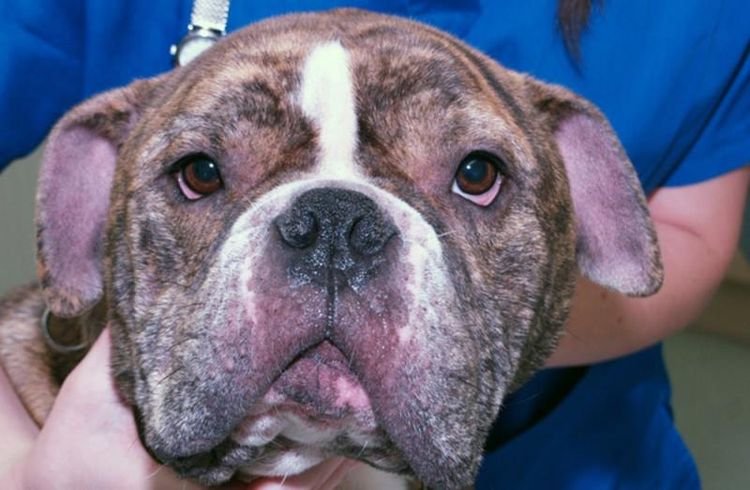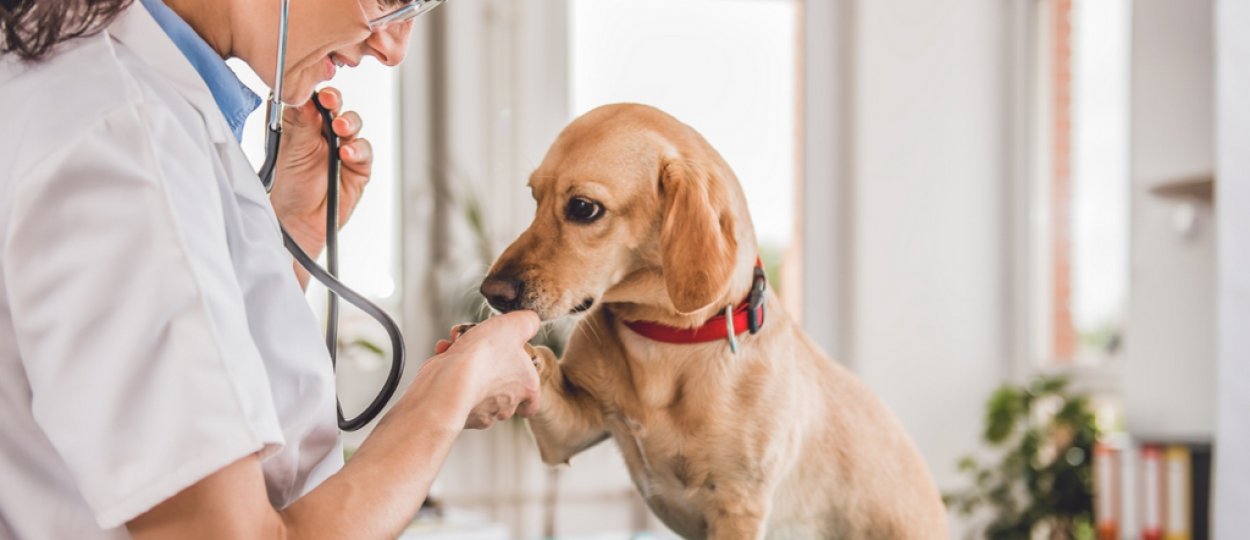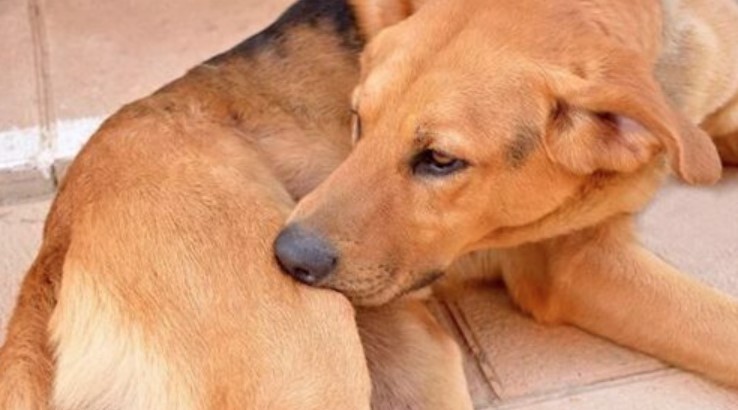Canine skin fungus is a common disease of dog skin and coat. If your dog is constantly itching, shedding fur, and has inflamed skin, then your four-legged friend is probably suffering from a fungal infection. Here you can find out which factors lead to skin fungus in dogs, which symptoms are typical, and which effective treatment methods are used.
What is skin fungus in dogs?

Skin fungus is one of the most common skin diseases in dogs. The medical term for skin fungus is dermatophytes. The types of fungi that are most widespread are yeast, Microsporum canis, and Trichophyton mentagrophytes. Fungal diseases are transmitted by tiny spores, which are not visible to the naked eye and spread very well.
Tiny fungal particles are attached to these highly infectious spores, which attach themselves to the skin and cause the fungus to spread there. First, the fungus forms a dense root system that anchors it deep in the skin. When this growth is complete in depth, the fungus spreads progressively to the sides of the first finding. The changes in the skin caused by it are expressed by redness, hair loss, dandruff and usually severe itching.
What to do about skin fungus in dogs?
If you have discovered abnormal skin areas on your dog and suspect it could be a skin fungus infestation, you should take your dog directly to the vet for treatment. Only he has methods for determining and can determine with certainty whether a skin fungus is actually present. The quicker it is found and treated, the shorter your dog’s ordeal will be and the lower the likelihood of it spreading to the dog’s environment.
What factors lead to skin fungus in dogs?
Young or very old dogs and dogs with a generally weakened immune system are particularly at risk of such skin diseases. Infection with skin fungus occurs either through direct contact with another infected living being or indirectly through contact with an already infected environment. This includes items such as blankets or brushes that have already been in contact with an infected dog and on which the fungal spores have not been killed.
The fungal spores can penetrate through tiny cracks in the skin, which every dog and every human has, and spread from there. Mushrooms also prefer a warm, humid climate. They spread particularly quickly in this area, which is why fungal infestation is not uncommon in dogs with poorly ventilated floppy ears, for example.
What does skin fungus look like in dogs?

Areas affected by skin fungus can appear anywhere on the body and often shed their fur. In addition, the skin is usually rough, reddened, scaly, or darkly overgrown. As a rule, the skin affected by the skin fungus can be clearly distinguished from healthy dog skin and is also easy to recognize for the layperson.
The dog has skin fungus: symptoms and diagnosis
In general, a skin fungal disease can be recognized quite well, for example when brushing the dog, but in an advanced stage also without a closer examination, since the diseased skin areas are clearly visible from afar. The symptoms associated with skin fungus are mostly hair loss, which occurs in clearly defined and rounded areas. Due to the lack of fur, skin changes become visible, which are usually darker in color than the healthy, unaffected skin.
In addition, the affected dog is plagued by severe itching, which it tries to combat by intensively scratching. In particularly severe cases, the diseased skin erupts in blisters. Redness or severe scaly skin can also be a sign of skin fungus. If there is a suspicion of such a fungal disease, it should definitely be treated by the veterinarian, since skin fungus is contagious for both other dogs and humans.
If a dog is presented to the vet with suspected skin fungus infestation, there are various diagnostic options and treatments available. They can be used to check whether the symptoms present are actually skin fungi:
Wood’s lamp
Some fungal spores have the property of glowing under black or UV light. This method is often used, especially when it comes to a quick diagnosis. However, it is not very reliable. Therefore, a positive result on this test should be reconfirmed by another method, and a negative result from Wood’s lamp does not rule out a fungal infection. Some types of fungi cannot be detected in this way because they do not have the property of fluorescing under short-wave light.
Biopsy
In a biopsy, a small sample of tissue is taken from the supposedly affected area of the skin. This is done with the help of biopsy forceps or a thick syringe. This tissue sample comprises several layers of the skin including the subcutis, which is cut into thin slices by the pathologist in the laboratory. Changes caused by a fungus can thus become visible.
How to recognize skin fungus in dogs?
Diseased areas can usually be easily recognized by the appearance of hair loss and severe itching of the bald areas. The diseased areas of skin are also usually reddened or show other optical differences to the adjacent, unaffected skin.
Examination under the microscope
The dog’s hair, including the hair root, can also provide information about whether a fungal infection is actually present. The hair samples are magnified under the microscope so that changes caused by a fungus can be seen.
Creating a fungal culture
Creating a mushroom culture is considered the safest method of identification, but it also takes a few days. A smear is taken from the diseased skin area, which is then placed on a culture medium and allowed to multiply there. Under a microscope, experts can then see the details and characteristics of the fungus and thus pinpoint the type of fungus. The type of fungus is important for treatment, as different types of fungi require different medications.
What helps against skin fungus in dogs?

So-called antimycotics help the dog’s organism to fight the fungus from the inside. At the same time, the skin and coat should be treated externally with antifungal agents to limit the spread of the fungus and alleviate symptoms.
Treatment methods and healing process
Since the infection rate of skin fungus for humans and animals is very high, thorough treatment is particularly important. The chances of treatment are good. However, the duration of the treatment can stretch over several months and must be carried out very conscientiously. The treatment is particularly easy if the skin fungus has been diagnosed at an early stage and the spread is not yet high.
The first step in combating the fungus is to first remove the affected and infectious hair and dander so that it cannot be spread further. Affected dogs are therefore often shorn. By administering antimycotics, which are administered either by injection or orally in the form of tablets or paste, the fungus is treated or combated from the inside.
In addition, the sick dogs are treated with special shampoos or other agents that are applied directly to the skin and have a local effect there. However, you have to treat the entire body and not just the affected region in order to effectively destroy all fungal spores and avoid reinfection.
All of these available measures should be used equally and carried out repeatedly until the veterinarian has found the fungus negative. It is also important to note that all objects that have come into contact with the infected dog must also be thoroughly cleaned and disinfected. This includes the dog bed, the brushes, collars and leashes, toys and ideally also the rooms in which the dog has stayed.
There are special solutions for this that kill fungi effectively and sustainably. If these measures are not implemented consistently and thoroughly, the dog or the human can become infected again and the plaguing circle of disease starts all over again.
Effectiveness of budget funds
According to the current state of science, the fungus itself cannot be treated with home remedies. For effective control, it requires tested drugs that are prescribed by the veterinarian. There are a few home remedies that can help relieve the itching that accompanies most fungal infections. However, these should only be used as first aid to relieve the dog of some itching and never replace extensive treatment by a veterinarian.
If itching, cottage cheese or yoghurt can be applied to the appropriate area. This cools and temporarily reduces the annoying itching. Apple cider vinegar is often recommended for dry skin. However, this should never be applied to open areas of skin, as the vinegar burns severely in an open wound and only causes further pain for the dog.
Is skin fungus contagious in dogs?
Yes. Skin fungus is one of the very highly contagious diseases, since the light and tiny fungal spores are easily transmitted through the air or direct skin contact. The risk of infection does not only exist among dogs. Infection with skin fungus can also occur from dogs to humans and from humans to dogs.
Risk of transmission from animals to humans
Skin fungus can be transmitted from humans to animals and vice versa. This type of transspecies infectious disease is called zoonosis. In principle, therefore, all vertebrates that come into contact with a fungal patient are at risk. However, the immune system of the respective dog or human plays a major role in whether or not contact will result in infection.
In order to protect yourself from infection by the dog, some hygiene measures should be observed. After contact with the dog, washing your hands thoroughly helps to remove any fungal spores from the skin. Keeping the dog away from your own bed or sofa can also help.
If a fungal disease has been found, all treatment measures should be carried out as quickly as possible and contact with other dogs or people should be reduced as far as possible. Children, pregnant women and people with a weak immune system in particular should then no longer come into contact with the sick dog, as they are among the risk patients who are easily susceptible to infection.
Preventive measures against skin fungus in dogs

There is always a risk of infection, since unfortunately there are also cases in which the fungus has not yet been noticed and fungal spores spread very easily. Contact with dogs already diagnosed with skin fungus should be avoided, as is inadvisable exposure to their environment until it has been decontaminated. Regular cleaning and disinfection of all the dog’s utensils can also prevent fungal infestation.
If your animal has been in contact with many other dogs, for example because it has stayed in an animal boarding house or a dog daycare center, you should examine it regularly and carefully for signs of skin fungus infestation. In addition, a strong immune system is very helpful in fighting such an infection effectively before the disease breaks out. A dog’s immune system can be supported by balanced feeding and plenty of exercise and exercise.





























